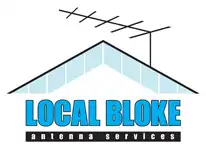Government Endorsed Antenna Installer Gold Coast. - Call 07 5593 7514
Not happy with the TV picture & sound quality that you are getting? One of the most irritating things is having a bad TV reception and fuzzy picture while watching your favourite programme. There are a variety of reasons for poor reception including: old and faulty antenna & cabling, tall structures and big mountains that impair the signal, local interference, signal overload etc. Not all the bad reception happens due to weak signals from the TV station and your attempt to improve the signal by adding an expensive masthead amplifier might make it even worse. Provided that, you know some basic TV reception facts and can do some fine-tuning, you can save you from making an expensive and frustrating mistake.
How a TV receiver works:
A TV receiver is an electronic device which grabs the TV station’s transmission signals (radio waves). This signal is then processed to video and audio signals to be played back on the TV. Radio and Cellular broadcasting also uses radio signals but the signals received by TV receivers are different as they carry video as well. TV broadcasting frequency uses the reserves VHF (Very High frequency) and UHF (Ultra High Frequency). The signals that radiate away from the TV stations can easily travel through the dry air and close to the straight line. If your antenna can receive the transmitted signals without much interference and can properly transmits the signals, your TV set should be able to demodulate them to recreate that station’s video and sound with excellent quality.
What are the reasons for poor reception?
Bad reception can happen for a variety of reasons. A remote location can be one of the reasons your antenna can’t grab strong signals and thus produce a poor picture and sound quality. Old antenna and cabling, line of sight, old TV set, broadcasting problems, presence of heavy appliances near the TV, authorized digging, and signal overload are some of the major issues that hinder signal transmission and reception.
Sometimes even if you have a clear line of sight and your receiver is placed within the range of the transmission tower, you can still get a bad reception due to heavy downpours or heavy snow. Bad weather has a direct impact on poor reception and the impact depends on the settings of your antenna and TV type. For some installation the picture can glitch for a couple of seconds and for others it might persist for a longer period.
Tall buildings, trees, high hills & cliff faces, metal structures, a big lake or a bay can reflect the VHF and UHF radio signals and thus produce a bad reception. The problem with the reflected radio signals is that they are received with the direct signals as well and produce fuzzy and ghost images.
Electromagnetic Interference (EMI), also known as the Radio Frequency Interference (RFI) is another main reason for poor reception. EMI from industrial heaters, FM broadcasting transmitters, diathermy machines, computers, sparking from a big motor drive system, power tool etc. tend to cause moving coloured lines or patterns superimposed on the picture -again creating fuzzy reception.
How to tackle weak signals:
As a rule of thumb, check your antenna & cable connections. Make sure there are no loose connections, broken antenna rods or loose plugs. Fixing these basic problems will help you solve the problem in many cases.
For weak signals that mainly happens due to the interference of metal structure, tall buildings or anything that blocks the antenna’s-view of a station’s transmitter tower. Ensure you have a good outside antenna. The antenna should be placed high off the ground so that it can receive signals better. The outdoor antenna you use should be able to receive the passing radio signals as strongly as possible. The stronger and smoother the reception, the better the sound and picture quality you will get. The special and fine-tuned antenna produced by some manufacturers can improve the performance significantly.
If your cable and antenna are in good condition, try to replace the splitter. Sometimes a new or updated splitter can significantly improve your TV reception strength.
Sometimes a digital converter box can give you really good results because most channels have switched to digital television as opposed to analog. This digital box will convert the analog signal into a digital signal and would produce a better picture quality.
Multipath reception problem (also known as a ghost image problem) happens due to signals reflecting from a solid body or tall structures and creating unexpected ghost images that mix up with the direct signals and affect image clarity. Solving the reflected image problem is sometimes quite difficult. However if you can carefully inspect your TV screen and can determine how far the ghost image is to the right of the main image as a proportion of total picture width, you can calculate the time in microseconds that the reflected signal is being delayed.
If more than one transmitter is covering your area, you will need to make sure that your antenna is pointing towards the one that provides stronger signals. Make sure that the antenna is correctly oriented to receive the strongest possible signals from the TV transmitters. In many cases, installing a high-gain or wide-brand antenna can produce better result. Every connection reduces the signal gain and reduces the quality. Keep your cabling as short and direct from the antenna to the TV set as possible. Antenna manufacturers add some extra elements (for instance: one or more special rods or a metal mesh) to form the reflector and deflector to increase the sensitivity of the antenna. Those special high gained antenna can improve the signal reception significantly and the most cost-effective way to ensure better TV reception is to use this kind of antenna that uses additional rods and elements to receive signals properly. Try to put the antenna as high as possible to receive the strongest possible signals from the waves coming from the TV transmitter.
Antenna Fundamentals:
An antenna is a device that can either transmit or receive guided electromagnetic waves in an unbounded medium. Antennas are frequency depended devices and each antenna can operate for a certain frequency of bands and ignores signals beyond the frequency range it is designed to work on. Radiation patterns, gain, efficiency input impedance and some other aspects affects the operational mode of an antenna.
A high-gain antenna allows more of the transmission signals to be received by the receiver while transmitting. On the contrary while receiving, it increases the signal strength and captures more of the signals.
Now the question is, when you can accommodate a 7dBi antenna instead of a 3dBi, should you go for it? While a 7dBi is a larger gain antenna than a 3dBi, a larger gain doesn’t always meet your requirements to give better performance. Your choice should be determined by factors such as your location, distance from the transmission, type of antennas and the signal strength.





